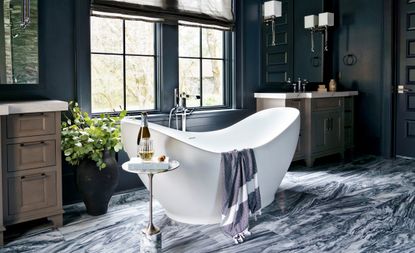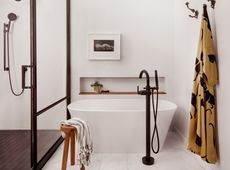This changes everything! Experts are advising we stay away from marble in small bathrooms. Here's why
Sure, we love the beauty and instant high-quality appeal of marble but the natural stone has many drawbacks too


If there has been one enduring bathroom trend of the last ten years it's marble. It seems to lift the space, giving it instant spa-like serenity. But did you know that the material's tile size, durability, maintenance, and more may not be suited to small spaces? Yes, you heard that right. The loved-by-all stone comes with its fair share of problems and - sometimes - should be avoided.
To give you a complete and detailed lowdown, we decided to reach out to experts, to understand their take on this natural stone, especially when it comes to small bathrooms.
Read along, and find out the pros, cons of marble, and some things you should watch out for when you’re considering it for your bathroom.

Aditi is a homes writer and editor with several years of experience. Her articles, backed by expert insights, offer suggestions aimed at helping readers make the best home design choices. For this article, she spoke to top experts from the industry to understand the cons of having marble in the bathroom.
Is marble right for small bathrooms?
Marble has covered palace floors, ceilings and walls for centuries and is a material that has been loved and revered since time immemorial. No longer considered a stone for only the wealthy marble today is a regular feature in many homes.
While cheaper marble tends to be white with grey veining, the more high-end varieties have an a larger color palette to choose from, and softer veining. And, when you go deeper into its use, look, cost and appearance, it appears that in small bathroom layout ideas, marble may not, as per experts, be the best one for this space.
'Whether you cover the entire bathroom with marble, or use it as an accent material, it brings great value addition to the space. However, it does come with several limitations that you need to be aware of,' says Meenu Agarwal, founder of MADS Creations.
Pros of marble in a small bathroom

Marble signifies luxury, class, and taste and when it comes to small spaces such as a powder room using marble can inject a big personality.
'Marble is a gorgeous choice for homes – small or big. It instantly elevates the look of spaces with its elegant and luminous surface,' says Meenu. 'Whether you go for dramatic veins or soft grains, it is sure to enhance the glamor and luxury quotient of the bathroom. Being available in many exotic shades, you can choose the one that best suits your design. You can contrast two different colors, or combine marble with other materials like tiles, wood, wallpaper.'
'The white marble bathroom trend is ever-enduring, providing unparalleled elegance, and ensuring an impressive look and feel,' says Mor Krisher, head of design at Caesarstone.
Marble works well with brass, another big bathroom trend that people love, so it's perhaps no surprise it has endured.

Linour Gold Wall Sconce from Amazon
This cut-glass and gold lighting piece is a great addition to a modern bathroom, and a wonderful task light to add next to the mirror.
Cons of marble in a small bathroom

There's always a flip side to a coin, and so, no matter how incredible marble may seem, the stone does come with its fair share of issues, and may not be the best small bathroom tile idea. If you're looking for something as fancy but would love to look for alternatives, another durable material is porcelain tiles.
'Natural stone has been used in the bathroom for millennia not only because of, in some cases, its opulence, but also its practicality,' says Oliver Webb, director of Cullifords. 'As with all stone groups, there are some hard marbles and some softer types. Generally, the softer the stone, the more porous and prone to staining it might be, whereas harder marbles aren’t as porous. I would suggest you go for the latter.'
'Marbles in general will develop a patina from small scratches and possible staining if the sealant does not work well,' says Oliver.
'Due to the high thickness of marble, the material can eat up a lot of space on top of it,' says Ritu Gupta, co-founder of Pramod Group. 'The marble concrete which is used for fixing takes up a lot of margins which in turn reduces a lot of space. While fixing marble tiles in small bathrooms, the pattern can get distorted as usually marble or stone pieces do not align well in small spaces. Being a soft stone, it is very absorbent. For example, if you dye your hair in a marble shower, the dye can stain your shower floor.'
'Marble is also easily etched by acidic materials, such as lemon and certain cleaning products,' says Ritu. 'If you want to use marble in your bathroom, you can first test the lotions and other bath supplies on samples to see if there’s a reaction .'
Another thing to think about is, that marble contains minerals, and runs the risk that its iron content may turn to rust. A beautiful installation can be ruined when the iron is buried deep in the marble, discoloring it from water and moisture.
What to choose instead of marble

Thankfully, other materials are starting to emerge in small bathrooms we're seeing at the moment. And brick is the way to go if you want to ahead of the curve.
Seen here on the floor of this small bathroom, it has the total opposite effect of marble. It's not grand, it's not polished, it's not obviously luxe. Instead it invites you to go bare foot, its warm and soft in color. It's causal, friendly. And nothing is more luxe than that.
How to maintain marble

If you're still in love with this material and are contemplating marble bathroom flooring, shower and countertop areas, then remember to seal the stone with a quality sealer and maintain it regularly. Avoid using strong cleansers to prevent etching or damage. Clean it with soap, water, and a good nylon scrub brush.
'Maintenance of marble is relatively simple – just clean with light soapy solutions,' says Oliver. 'It’s important to remember that even though staining can occur, all stains can be removed with a poultice and the great thing with marble is that it can be re-polished in situ if needed. I would avoid dark marble in a wet area, and opt for honed over polished finishes as this will be more durable and make the floors less slippery when wet,' says Oliver.
'You will need to choose the marble carefully as you want the entire design to look like it’s made from one continuous material,' says Mor. 'This is difficult to do with marble, granite, or any other material that contains natural veining. Mismatched veining will ruin the cascading effect.'
Be The First To Know
The Livingetc newsletter is your shortcut to the now and the next in home design. Subscribe today to receive a stunning free 200-page book of the best homes from around the world.
Aditi Sharma Maheshwari is an architecture and design journalist with over 10 years of experience. She's worked at some of the leading media houses in India such as Elle Decor, Houzz and Architectural Digest (Condé Nast). Till recently, she was a freelance writer for publications such as Architectural Digest US, House Beautiful, Stir World, Beautiful Homes India among others. In her spare time, she volunteers at animal shelters and other rescue organizations.
-
 People With Spa Bathrooms Will Likely Have These 8 Things — Get the Look With Our Checklist
People With Spa Bathrooms Will Likely Have These 8 Things — Get the Look With Our ChecklistHomeowners with spa-like bathrooms typically have these seven things, how many do you have?
By Oonagh Turner Published
-
 7 Vegetables You Can Plant in February – Our Favorite Varieties That Can be Either Sown or Planted Outdoors Now
7 Vegetables You Can Plant in February – Our Favorite Varieties That Can be Either Sown or Planted Outdoors NowGet planting these easy salad and vegetable varieties now and you will soon have plenty of fresh early spring crops
By Sarah Wilson Published

